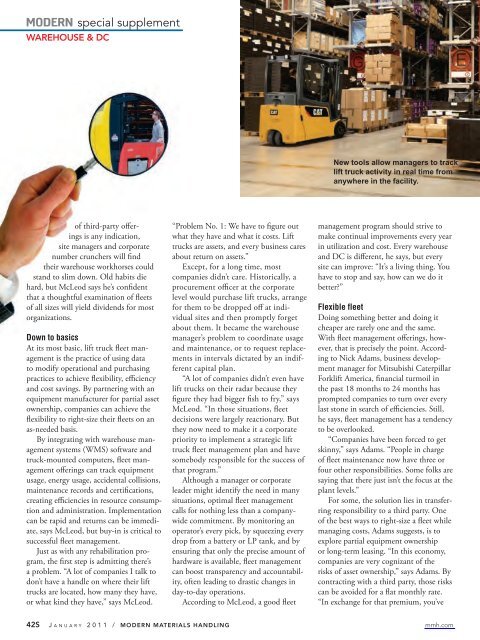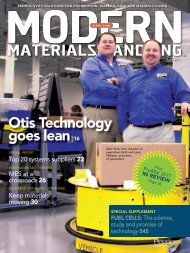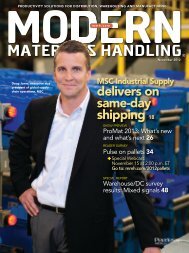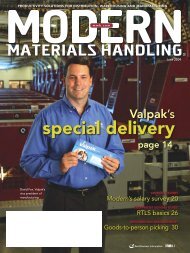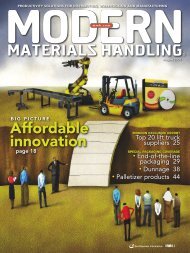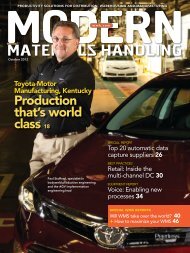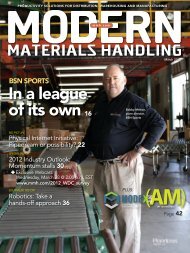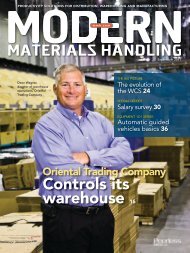Modern Materials Handling - January 2011
Modern Materials Handling - January 2011
Modern Materials Handling - January 2011
You also want an ePaper? Increase the reach of your titles
YUMPU automatically turns print PDFs into web optimized ePapers that Google loves.
modern special supplementwareHouSe & dCNew tools allow managers to tracklift truck activity in real time fromanywhere in the facility.of third-party offeringsis any indication,site managers and corporatenumber crunchers will findtheir warehouse workhorses couldstand to slim down. Old habits diehard, but McLeod says he’s confidentthat a thoughtful examination of fleetsof all sizes will yield dividends for mostorganizations.Down to basicsAt its most basic, lift truck fleet managementis the practice of using datato modify operational and purchasingpractices to achieve flexibility, efficiencyand cost savings. By partnering with anequipment manufacturer for partial assetownership, companies can achieve theflexibility to right-size their fleets on anas-needed basis.By integrating with warehouse managementsystems (WMS) software andtruck-mounted computers, fleet managementofferings can track equipmentusage, energy usage, accidental collisions,maintenance records and certifications,creating efficiencies in resource consumptionand administration. Implementationcan be rapid and returns can be immediate,says McLeod, but buy-in is critical tosuccessful fleet management.Just as with any rehabilitation program,the first step is admitting there’sa problem. “A lot of companies I talk todon’t have a handle on where their lifttrucks are located, how many they have,or what kind they have,” says McLeod.“Problem No. 1: We have to figure outwhat they have and what it costs. Lifttrucks are assets, and every business caresabout return on assets.”Except, for a long time, mostcompanies didn’t care. Historically, aprocurement officer at the corporatelevel would purchase lift trucks, arrangefor them to be dropped off at individualsites and then promptly forgetabout them. It became the warehousemanager’s problem to coordinate usageand maintenance, or to request replacementsin intervals dictated by an indifferentcapital plan.“A lot of companies didn’t even havelift trucks on their radar because theyfigure they had bigger fish to fry,” saysMcLeod. “In those situations, fleetdecisions were largely reactionary. Butthey now need to make it a corporatepriority to implement a strategic lifttruck fleet management plan and havesomebody responsible for the success ofthat program.”Although a manager or corporateleader might identify the need in manysituations, optimal fleet managementcalls for nothing less than a companywidecommitment. By monitoring anoperator’s every pick, by squeezing everydrop from a battery or LP tank, and byensuring that only the precise amount ofhardware is available, fleet managementcan boost transparency and accountability,often leading to drastic changes inday-to-day operations.According to McLeod, a good fleetmanagement program should strive tomake continual improvements every yearin utilization and cost. Every warehouseand DC is different, he says, but everysite can improve: “It’s a living thing. Youhave to stop and say, how can we do itbetter?”Flexible fleetDoing something better and doing itcheaper are rarely one and the same.With fleet management offerings, however,that is precisely the point. Accordingto Nick Adams, business developmentmanager for Mitsubishi CaterpillarForklift America, financial turmoil inthe past 18 months to 24 months hasprompted companies to turn over everylast stone in search of efficiencies. Still,he says, fleet management has a tendencyto be overlooked.“Companies have been forced to getskinny,” says Adams. “People in chargeof fleet maintenance now have three orfour other responsibilities. Some folks aresaying that there just isn’t the focus at theplant levels.”For some, the solution lies in transferringresponsibility to a third party. Oneof the best ways to right-size a fleet whilemanaging costs, Adams suggests, is toexplore partial equipment ownershipor long-term leasing. “In this economy,companies are very cognizant of therisks of asset ownership,” says Adams. Bycontracting with a third party, those riskscan be avoided for a flat monthly rate.“In exchange for that premium, you’ve42S J anuary <strong>2011</strong> / <strong>Modern</strong> MaterialS <strong>Handling</strong>mmh.com


